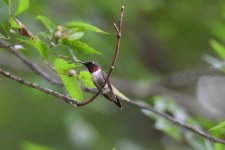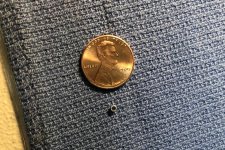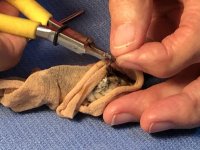Faulkner
Member
As I walked in the door from work one day earlier this week I hung my duty belt on the peg in the mud room and slide my Glock 23 into the lock box on the high shelf, Mrs. Faulkner greets me and said, "guess what I saw today?"
"What did you see," I answered.
"A banded ruby-throated hummingbird."
"A banded hummingbird?" I replied. "I've never heard of such. You mean like a band around it's leg like a banded mallard?"
She smiled, "exactly like that. I was taking pictures of my hummingbirds this morning and I noticed something shiny on the leg of one of them. When I downloaded the pictures I could see the band plain as day, but I couldn't see if had anything on it because it was too small. So, I got on line to look it up and found out that one of the few places that band hummingbirds in North America is in Arkansas."
"Where is that?" I asked.
"They do it at Potlatch Conservation Education Center at Cook's Lake," she answered.
"Where is that?" I repeated
She looked at some notes she had taken and said, "It said on the web page it was near Casscoe, Arkansas."
"Where is that?" I've lived in Arkansas my whole life and I've never heard of Casscoe.
"I think it's east of Stuttgart."
I was sitting in a chair at the kitchen table and had my uniform shirt off and had shucked my ballistic vest. Mrs. Faulkner handed me a glass of iced tea.
"Stuttgart? That's in southeast Arkansas, down in the Grand Prairie where all that rice farming goes on. There's a bunch of minnow farms down there too, several of my buddies used to go frog gigging at night around those minnow ponds back in high school. Man, we used to see some monster water moccasins around those minnow ponds at night."
She scrunched up her nose as I mentioned the water moccasins and said, "I don't know about the snakes, but I called the number I found on the web page for the Education Center at Cook's Lake and actually talked to the lady that does the hummingbird banding. They usually only do public banding of the birds on Saturday, but she said if we could come down tomorrow she would do a demonstration for us. We can take our camera gear and get some pictures too, they have a lot of hummingbirds.
I pulled out my iPhone and went to Google Maps and searched for Casscoe, Arkansas.
"Wow," I said. "That's clear across the state. Looks like about a 3 hour drive."
"Can we leave early so we can get there by 9:00 am. Oh, she said we'd need some bug spray because the mosquitoes are thick there." I guess were going to Casscoe.
So, we left out before 6:00 the next morning for a early morning drive across the state. At least we got ahead of the traffic as we went through Little Rock. When we pulled into Casscoe there was no wonder I had never heard of it, it was little more than a highway intersection and a church with a few farm places scattered about. We turned off the main highway onto a chip seal road and followed the signs pointing to the education center. After a mile or so the hard road gave way to gravel and we traveled it another couple of miles to the center that was nestled in the middle of some big timber.
The nice folks at the education center greeted us as we parked and got out of the vehicle. This place is way out in the boonies so I doubt they get very many unexpected visitors. After introductions they gave us a brief tour of the facilities and then lead us to the area behind the building where they have half a dozen hummingbird feeders that were swarming with hummingbirds. As we unpacked our camera gear they explained how they go about capturing and banding the hummingbirds. It's a very interesting process and they said they band about 3,000 hummingbirds a year.
We set up our camera gear and took pictures of the dozens and dozens of hummingbirds for about 45 minutes. They are fast little boogers and you have to be quick to capture them with the camera. I think Mrs. Faulkner could have stayed all day just to take pictures, but the time came for them to demonstrate the banding process. They set up a large live trap, just like what I use to live trap raccoons at home, but this one had been modified with openings on the side and a hinged trap door on the top. They hung a feeder inside the live trap and then took all of the other feeders inside out of reach of the hummingbirds.
With the other feeders gone it didn't take long for them to home in on the feeder inside the trap. They flew in the side openings to feed, but with the trap door closed on top they couldn't get back out. Once there were a dozen or so inside the trap the biologist walked up with a small nylon sack and reached in and snagged one of the birds. Once she had it in hand, she opened the trap door on top and all the other birds flew out. They immediately brought out the other feeders and hung them back out and brought the trap inside.
She held the bird gently in her hand with it's beak protruding through the nylon bag as we headed to the banding work table. The nylon bag kept it from moving around and hurting itself. The band is a tiny little thing and I pulled out a penny and took the picture below to show it's comparable size. The biologist has a modified pair of needle nose pliers that hold the band so that they can slip it over the leg and then squeeze it shut without hurting the hummingbird's leg. Once the band the log the number on the band and measure the wing length, the length of the beak, weight it, and log it's gender.
Once they were finished with the banding process and logging all of the information, the biologist handed the hummingbird to Mrs. Faulkner and let her hold it. She was excited and could actually feel the heartbeat of the little fellow. With bird in hand we walked back outside so that she could release the bird. Mrs. Faulkner opened her hand and peeled open the nylon bag and the bird poked it's head out, looked around a bit, then took off. It was all very exciting.
The folks at the Potlatch Conservation Education Center at Cook's Lake were extremely gracious during our visit and we had a great time and we learned a great deal about hummingbirds that we didn't know and it was well worth the 6 hour round trip drive.





"What did you see," I answered.
"A banded ruby-throated hummingbird."
"A banded hummingbird?" I replied. "I've never heard of such. You mean like a band around it's leg like a banded mallard?"
She smiled, "exactly like that. I was taking pictures of my hummingbirds this morning and I noticed something shiny on the leg of one of them. When I downloaded the pictures I could see the band plain as day, but I couldn't see if had anything on it because it was too small. So, I got on line to look it up and found out that one of the few places that band hummingbirds in North America is in Arkansas."
"Where is that?" I asked.
"They do it at Potlatch Conservation Education Center at Cook's Lake," she answered.
"Where is that?" I repeated
She looked at some notes she had taken and said, "It said on the web page it was near Casscoe, Arkansas."
"Where is that?" I've lived in Arkansas my whole life and I've never heard of Casscoe.
"I think it's east of Stuttgart."
I was sitting in a chair at the kitchen table and had my uniform shirt off and had shucked my ballistic vest. Mrs. Faulkner handed me a glass of iced tea.
"Stuttgart? That's in southeast Arkansas, down in the Grand Prairie where all that rice farming goes on. There's a bunch of minnow farms down there too, several of my buddies used to go frog gigging at night around those minnow ponds back in high school. Man, we used to see some monster water moccasins around those minnow ponds at night."
She scrunched up her nose as I mentioned the water moccasins and said, "I don't know about the snakes, but I called the number I found on the web page for the Education Center at Cook's Lake and actually talked to the lady that does the hummingbird banding. They usually only do public banding of the birds on Saturday, but she said if we could come down tomorrow she would do a demonstration for us. We can take our camera gear and get some pictures too, they have a lot of hummingbirds.
I pulled out my iPhone and went to Google Maps and searched for Casscoe, Arkansas.
"Wow," I said. "That's clear across the state. Looks like about a 3 hour drive."
"Can we leave early so we can get there by 9:00 am. Oh, she said we'd need some bug spray because the mosquitoes are thick there." I guess were going to Casscoe.
So, we left out before 6:00 the next morning for a early morning drive across the state. At least we got ahead of the traffic as we went through Little Rock. When we pulled into Casscoe there was no wonder I had never heard of it, it was little more than a highway intersection and a church with a few farm places scattered about. We turned off the main highway onto a chip seal road and followed the signs pointing to the education center. After a mile or so the hard road gave way to gravel and we traveled it another couple of miles to the center that was nestled in the middle of some big timber.
The nice folks at the education center greeted us as we parked and got out of the vehicle. This place is way out in the boonies so I doubt they get very many unexpected visitors. After introductions they gave us a brief tour of the facilities and then lead us to the area behind the building where they have half a dozen hummingbird feeders that were swarming with hummingbirds. As we unpacked our camera gear they explained how they go about capturing and banding the hummingbirds. It's a very interesting process and they said they band about 3,000 hummingbirds a year.
We set up our camera gear and took pictures of the dozens and dozens of hummingbirds for about 45 minutes. They are fast little boogers and you have to be quick to capture them with the camera. I think Mrs. Faulkner could have stayed all day just to take pictures, but the time came for them to demonstrate the banding process. They set up a large live trap, just like what I use to live trap raccoons at home, but this one had been modified with openings on the side and a hinged trap door on the top. They hung a feeder inside the live trap and then took all of the other feeders inside out of reach of the hummingbirds.
With the other feeders gone it didn't take long for them to home in on the feeder inside the trap. They flew in the side openings to feed, but with the trap door closed on top they couldn't get back out. Once there were a dozen or so inside the trap the biologist walked up with a small nylon sack and reached in and snagged one of the birds. Once she had it in hand, she opened the trap door on top and all the other birds flew out. They immediately brought out the other feeders and hung them back out and brought the trap inside.
She held the bird gently in her hand with it's beak protruding through the nylon bag as we headed to the banding work table. The nylon bag kept it from moving around and hurting itself. The band is a tiny little thing and I pulled out a penny and took the picture below to show it's comparable size. The biologist has a modified pair of needle nose pliers that hold the band so that they can slip it over the leg and then squeeze it shut without hurting the hummingbird's leg. Once the band the log the number on the band and measure the wing length, the length of the beak, weight it, and log it's gender.
Once they were finished with the banding process and logging all of the information, the biologist handed the hummingbird to Mrs. Faulkner and let her hold it. She was excited and could actually feel the heartbeat of the little fellow. With bird in hand we walked back outside so that she could release the bird. Mrs. Faulkner opened her hand and peeled open the nylon bag and the bird poked it's head out, looked around a bit, then took off. It was all very exciting.
The folks at the Potlatch Conservation Education Center at Cook's Lake were extremely gracious during our visit and we had a great time and we learned a great deal about hummingbirds that we didn't know and it was well worth the 6 hour round trip drive.








